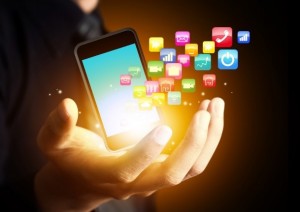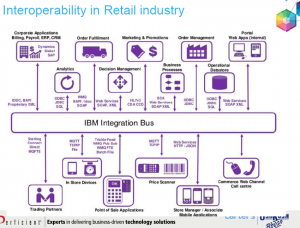It was a great week at IBM Interconnect with so many great sessions to choose from, activities to participate in, and networking to be had. I want to share my thoughts on one session in particular that was of interest – Carter’s “Creating a Smarter Shopping Experience”. During the session I was reflecting on all the retailers we are working with to build innovative technology solutions to woo the connected consumers of today and how shopping has evolved from park the car, pick from the shelves, check out and bring home. Shopping has also evolved from search online, add to cart, pay and wait for delivery. Rich pins on Pinterest, Likes on Facebook and hashtags on Twitter drive purchases of goods and services.
Retailers like Target, Carters, JCrew, Nordstrom, Starbucks etc. have begun to incorporate social networking channels into their campaigns. The consumer is now ‘connected’, ‘always-on’ and being bombarded by marketing campaigns from competitors all over the globe. Although, consumers still make the conventional decision of buying what they need and when they need it, alternative business models are making their way front-and-center to reap the benefits of understanding the consumer behavior. Thousands of analytics apps scour heaps of structured and unstructured data, to figure out what and when the consumer will buy and most importantly, what the consumer feels.
The ‘Connected’ Consumers defined:
- They rely on social channels to guide purchases.

- They expect personalized experience, tailored to their needs.
- They want mobile alerts on promotions, special events and recommendations based on purchasing history.
- They want a 360 degree view of the product, not only physical looks from every angle, but also technical specifications, reviews, market trends, price match and customer ratings at their fingertips.
- They expect broad assortments, ‘endless aisles’ and competitive pricing for products of interest.
- They need flexible order systems, where order should be received from any channel – store, online, mobile, call center and shipped from anywhere – manufacturer, distribution center or store.
- They demand faster and flexible delivery and return options in hours, days, and weeks or scheduled for months later.
- And…. all this via a wearable device, if you please!
Initiatives to make it work
Tight coupling of customer engagement systems, marketing technology and social tools enable better understanding of shopper behavior and patterns. Creation of social profiles in social CRM systems, like Salesforce, use of social listening and real – time insights with tools like IBM’s Consumer Insights could be put to work. It may require re-inventing email marketing programs and lead management.
Investment in data analytics to track consumers’ purchasing patterns, social media monitoring and sentiment analysis provides a sure shot payback. The adoption of Internet of Things has a huge impact on future business models where sensors in brick-and-mortar stores will help gather and process data. IBM’s InfoSphere BigInsights, Apache Cassandra and Hadoop facilitate scalable and affordable real-time analysis. Fast delivery can be achieved by an in depth understanding of getting the right items to the right locations at the right time. This implies that inventories are managed and updated in real time, order management and logistics systems are fully integrated and tuned to work in synchronization.
To extract value from mobile for the connected consumer the key factors for engagement are personalization, contextualization and geo-location. A robust mobile strategy that encompasses these factors will stand the test of constant digital disruption.
Web APIs are the magic words that bond cloud, social and mobile technologies to work in unison for a common goal. These lightweight software interfaces streamline access to product information, store inventory, location details and mashups of other APIs from various sources. All systems throughout Amazon communicate via APIs. Several other APIs from leading retailers like Target, eBay, Best Buy can be quickly consumed to spin up a new site.
Now wearable technology is the hottest consumer trend that needs to be taken heed of, when developing shopping experience. Data from wearable technology can be funneled into existing ecosystems for personalized shopping experience. Mobile-friendly websites reduce shopping card abandonment. Websites should be optimized for mobile devices and integrated with mobile couponing and mobile payments. Mobile enabled loyalty programs keep customers engaged and add value to brand interactions. Self-service kiosks, enabling technologies like mobile, Bluetooth low energy (BLE), clienteling software and retail apps are facilitating and further enhancing the retail experience, uncovering new revenue sources and enable one-to one marketing.
A seamless approach to customer experiences available through all shopping channels, a single view of shopper derived from personal profiles and a single database of products, prices and promotions is the Holy Grail, and the path is strewn with challenges. Legacy applications and business functions require transitioning to newer tools and applications.
With careful approach of building interfaces across projects in an incremental fashion, establishing integration standards and best practices for across projects, the possibilities are practically endless. I left InterConnect more determined than ever to get our teams engaged with top retailers, and all industries really, to keep them relevant, innovative, and competitive in their marketplace. Then I rested my weary feet after a week in Las Vegas. J

